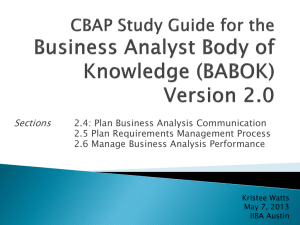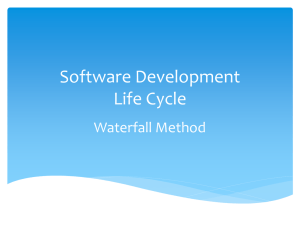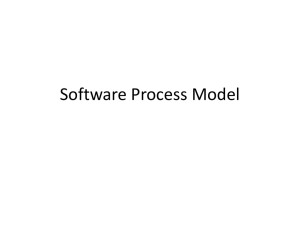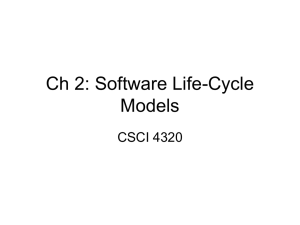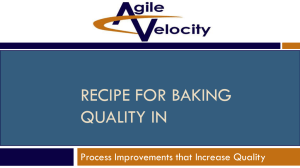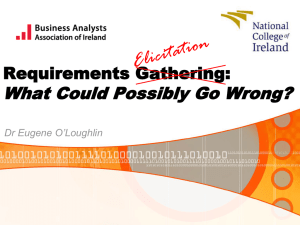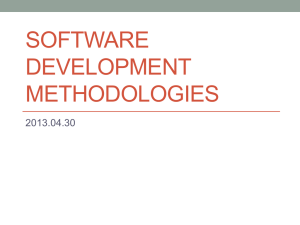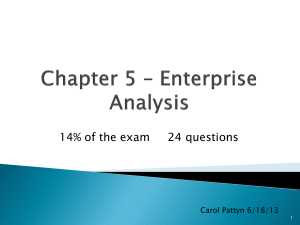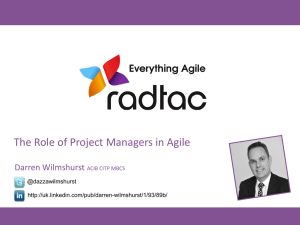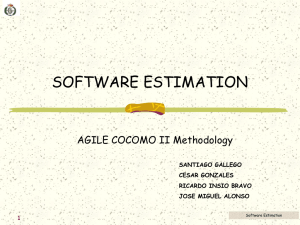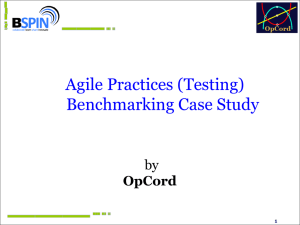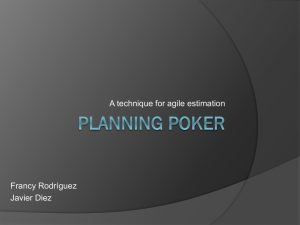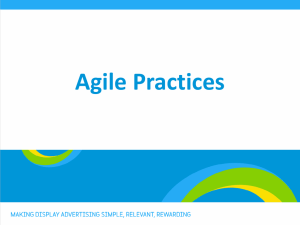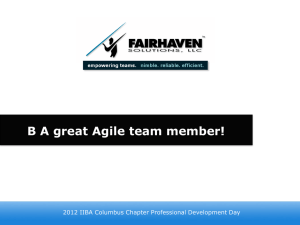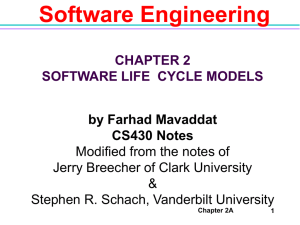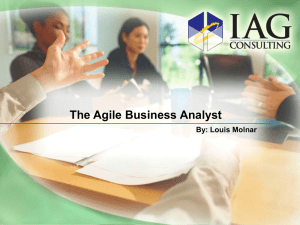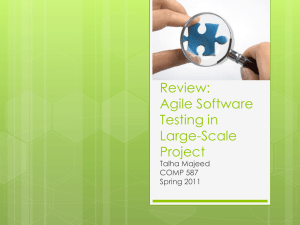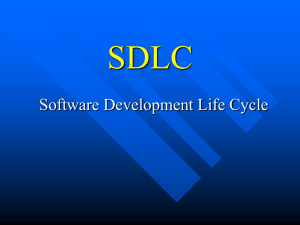Meeting Slides - Boston Chapter of the IIBA
advertisement
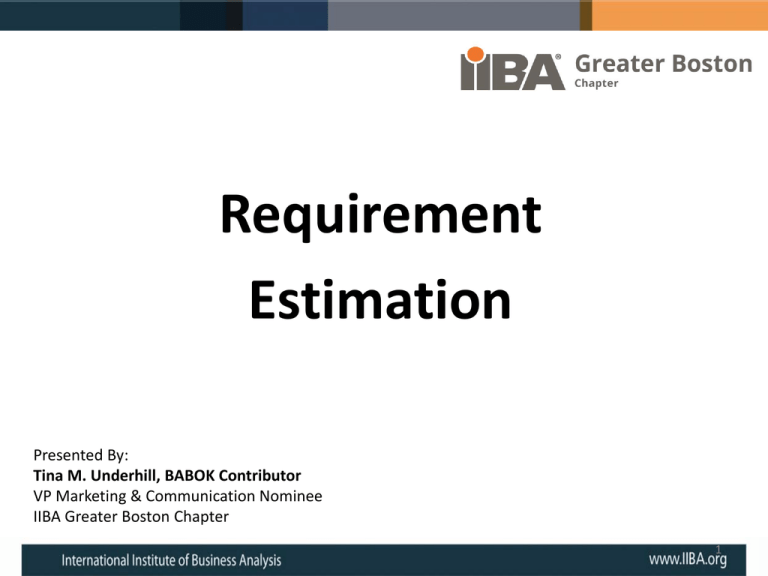
Requirement Estimation Presented By: Tina M. Underhill, BABOK Contributor VP Marketing & Communication Nominee IIBA Greater Boston Chapter 1 Agenda • • • • • • • • • • About the Speaker Housekeeping Session Overview BABOK 2.0 Definitions The BA Role BA Tasks BA Activities BABOK 3.0 Concepts Wrap Up Q&A 2 About the Speaker Tina M. Underhill is a senior-level Business Analyst Consultant with over 25 years of business operations experience within the finance, insurance, and retail industries at such companies as: AT&T, Key Bank, Humana Health Insurance, [FPIC] The Doctors, Bank of America, GM Financial, Express Scripts, Commerce/Mapfre, and TJX. As an active member of the International Institute of Business Analysis (IIBA) she is contributing to the BABOK version 3.0 under Solution Assessment & Validation. As an active member of the IIBA Greater Boston Chapter she is a nominee for the VP of Marketing & Communication. In 2012, she served as a panelist at Project Summit & Business Analyst World in Burlington on Agile Requirements and will be presenting this year about Agile Requirements. Currently, she is serving as a Principal Business Analysis Consultant with Content Raven, a cloudbased content control solution software company [Agile], as well as serving as a Business Analysis Consultant at Staples’ corporate headquarters in Framingham on the dotcom team [Waterfall/Agile]. She holds multiple AS Degrees from Florida State College in Business and IT disciplines. 3 Housekeeping • • • • Respect the conversation – keep your phones on MUTE. Realize that we won’t solve everything in the session. Feel free to politely “interrupt” the speaker – if you have a question, make sure it gets captured in the question space. We may not answer it now (parking lot), but it is best to capture thoughts and questions in the moment they are relevant. The Parking Lot will be used for questions that cannot be answered, issues or unrelated topics – we will post directives within 48 business hours after the session. 4 Session Overview This session is intended to: •Provide definitions and glossary terms from the BABOK disciplines that are intended to guide the Business Analyst down the right path •Help BAs understand what the process is, what the many tasks and activities that are performed inside the process and what the differences are within a Waterfall and Agile methodologies. •Showcase the Business Analyst’s positive contribution in Requirement Estimation within both the Waterfall and Agile methodologies in both large and small organizations. •How to use real ingenuity to get the right estimation plan into place. 5 Definitions: Business Analysis Body of Knowledge BABOK version 2.0 defines Requirement Estimation in the following area: Knowledge Area – Chapter 9: Techniques - 9.10 Estimation (p.70) This technique is assigned to the following Knowledge Areas in the BOK (v.2): Knowledge Area – Chapter 2: Business Analysis Planning & Monitoring Knowledge Area – Chapter 5: Enterprise Analysis There is a GAP: The BOK does not address how to plan for “construction”. 6 Chapter 9 – Techniques Section 9.10 - Estimation: Estimating techniques forecast the cost and effort involved in pursuing a course of action. Good Forecasting Changes the budget POSITIVELY Estimates can help stakeholders make better decisions; but can also have stakeholders “assuming” estimates are commitments! Prevent a RISK: Ensure the stakeholders know the difference! 7 What is the Business Analyst’s role? Insurance Retail Finance SMALL Or LARGE Enterprise: Size Culture Industry Location IT Or Business Onsite Vs Offsite 8 What is the Process? 9 Who is in the Process? 10 Estimation Methods – the How Method Definition When to Use 9.10.3.1 Analogous Agile A “top-down” approach performed at the beginning of a project/phase with more estimates performed when more is known. When there is little known. 9.10.3.2 Parametric Waterfall Parameters are used along with how many there will be. For example: one use case = 20 hours, 10 cases x 20 hours = 200 hours. When there is enough history available to be used as a basis of comparison. 9.10.3.3 Bottom-up Waterfall Includes deliverables, activities, tasks, and estimates from stakeholders. These are then rolled up to get a total for all activities and tasks. It is more granular. When you want to produce the most accurate and defensible estimates. 9.10.3.4 Rolling wave Agile This involves refining of the initial estimates for all the activities so the estimates for the next iteration can be made. When the end of an iteration approaches. 9.10.3.5 Three-point Waterfall Uses scenarios in these three stages: most optimistic, most pessimistic, and most likely estimates. When Use Cases are used versus granular requirements. 9.10.3.6 Historic Agile Uses “history” as the basis. Similar to analogous but not used for just top-down estimation. When there are detailed tasks and there are prior project records. 9.10.3.7 Expert Judgment Agile Relies on the expertise of those who have done the work in the past. When the same resources are available or the resource has a principal level of knowledge. 9.10.3.8 Delphi Agile Uses a combination of expert judgment and history estimation techniques. They include: individual estimates, sharing the estimates with experts, and having several rounds until consensus is reached and then using the average. When an average can be derived by taking the optimistic, pessimistic and 4x the most likely, then dividing by 6. 11 Analogous vs Parametric Business Case: Annual 5k road race, that has three primary components: marketing, registration, and race-day coordination. Marketing: 500 flyers are needed to be printed up at a cost $0.20 each. Details: It took two weeks for the flyers to be printed for last year Registration: Design an on-line registration form and the cost to host on the website. Details: Last year it took one week to design and the cost to host the registration website was $850.00 Coordination: There are four people used to coordinate the race. Details: Each resource will be paid $25 per hour and they will be working an estimated seven hours, based on the race last year. Analogous How long will this take for the Marketing materials? How much will the Registration cost to host? Parametric How much will the Marketing cost? How much will the Coordination cost? How long will the Registration take? How long will this take to Coordinate? Summary: Both of these methods can be used for duration and cost because of historical info and expert judgment. The difference is that analogous is less accurate. 12 Bottom-Up Business Case: Annual 5k road race, that has three primary components: marketing, registration, and race-day coordination. Marketing: 500 flyers are needed to be printed up at a cost $0.20 each. Details: It took two weeks for the flyers to be printed for last year Registration: Design an on-line registration form and the cost to host on the website. Details: Last year it took one week to design and the cost to host the registration website was $850.00 Coordination: There are four people used to coordinate the race. Details: Each resource will be paid $25 per hour and they will be working an estimated seven hours, based on the race last year. Task 1: Determine actual cost of flyers Task 2: Get estimates from three printers Task 3: Get actual costs What other tasks would we perform for this granular estimate? Summary: This is a detailed assessment of the resources, capabilities, and amounts are used to determine an accurate duration or cost estimate. 13 Three-Point Project: Introduction of a three-tiered Customer Service Resolution Center Details: Three-tiers include: Routine Questions; Medium Questions, Complex/Supervisory Questions Resolution Times: Routine Questions take 1-3 minutes, Medium Questions take 4-6 minutes, Complex Questions take 6+ minutes Staff Allocation: 50 Routine CSRs, 20 Medium CRSs, 10 Complex CSRs Call Volume: 100-120 routine calls per rep per day with call transfers to the Medium and Complex areas Task 1: Determine the best-case estimate Task 2: Determine the most likely estimate Task 3: Determine the worst-case estimate Estimate = (T1 + 4[T2] + T3) / 6 Summary: This is a statistical formula with a weighted average to base your estimation of phone coverage. 14 Rolling Wave Project: 10-day Vacation at Walt Disney World in Lake Buena Vista, FL Stakeholders: You and your family , including 3 kids (6-boy), (11-girl) (16-girl) have never been to the “World”. I ternary: Flight from Worcester Airport to Orlando International Airport on Aug 3 – Aug 12 Details: There are (4) Theme Parks, (2) Water Parks, Downtown Disney Marketplace, and many other activities including fishing excursions, horse back riding, golf, guided tours What is needed: Theme Park tickets, Water Park tickets, meals, daily guide plans Decision 1: Tickets: One park per day, park hopper, waterpark and more Decision 2: Meals: Sit-down dinners, quick service meals, dinner shows, ala carte, grocery store Decision 3: What is important? DAY 1 3 Details DAY 2 Meal Place Park DAY 3 Meal Place Park Must have rides WHAT IS YOUR PLAN? DAY 4 Meal Place Menu Park All rides Evening details 15 Rolling Wave Project: 10-day Vacation at Walt Disney World in Lake Buena Vista, FL Stakeholders: You and your family , including 3 kids (6-boy), (11-girl) (16-girl) have never been to the “World”. I ternary: Flight from Worcester Airport to Orlando International Airport on Aug 3 – Aug 12 Details: There are (4) Theme Parks, (2) Water Parks, Downtown Disney Marketplace, and many other activities including fishing excursions, horse back riding, golf, guided tours What is needed: Theme Park tickets, Water Park tickets, meals, daily guide plans Decision 1: 5-day Ticket with Park Hopper and Water Park Fun & More Options Decision 2: Meals will include 3 sit-down dinners, Mickey’s backyard BBQ, and the famous Hoop Dee Doo Musical Revue, and then some quick service meal options. Decision 3: Planning in some resort time for actual rest is a must! DAY 1 Arrive on Magical Express Check In Hit the Parks! DAY 2 Breakfast at Resort MK Lunch at Crystal Palace Day break at Resort Mickey’s Backyard BBQ DAY 3 AK – Breakfast at Tusker House Expedition Everest Kali River Rapids Lunch at Pizzafari Kilimanjaro Safaris Maharajah Jungle Trek DAY 4 Breakfast at Resort Blizzard Beach Chair Lift Summit Plummet Melt-Away Bay Lunch at Avalunch Pulled Pork Slaw Dog Mac and Cheese Dog Head back to Resort Hoop Dee Doo Musical Revue Summary: Rolling wave is planning from one time period to the next with each additional time period being more detailed. 16 Historic – Expert - Delphi Project: Convert legacy customer service platform to new environment Details: The claims system was converted from January 2011 – April 2013 and included over 20000 work hours across all areas. Phases will included: Define, Estimate, Construct, Test, Implement Determine Fact 1: How long did it take for the claim system conversion? January 2011 – January 2012 = 12 months January 2012 – January 2013 = 12 months January 2013 – April 2013 = 3 months (27 months x 4 weeks = 108 weeks) x 40 hours = 4320 hours Determine Fact 2: How many man hours were allocated? # of resources on project = 5 History is the basis for this estimate 17 Historic – Expert - Delphi Project: Convert legacy customer service platform to new environment Details: The claims system was converted from January 2011 – April 2013 and included over 20000 work hours across all areas. Phases will included: Define, Estimate, Construct, Test, Implement Determine Fact 1: How long did it take for the claim system conversion? Determine Fact 2: How many man hours were allocated? Hx Data Interviews Brainstorming What kind of questions could we come up with? Whose expert judgment would we rely on? Summary: Historic estimates take statistical history, Expert Judgment takes addition factors into consideration, Delphi is a combination of the two. 18 BA Tasks: Waterfall Technique Methodology BA Role Analogous Waterfall BA starts from scratch on a very high level. Parametric Waterfall BA draws from similar projects and parameters of similar size, scale and functionality. [Can also be done in Agile] Bottom-up Waterfall BA defines the estimate by specific requirement details. Three Point Waterfall BA draws from Use Cases/Scenarios in Easy, Medium, and Complex states. 19 BA Tasks: Agile Technique Methodology BA Role Rolling Wave Agile BA uses one iteration estimate to form the next one. Historic Agile BA draws a strong analogy to projects and tasks of similar size, scale and functionality. Expert Agile BA draws from the expertise of the developers and their past experiences. Delphi Agile BA draws from history and expertise. 20 Definitions: Business Analysis Body of Knowledge BABOK version 3.0 defines Requirement Estimation in the following area: Knowledge Area – Techniques - Estimation: Specific content is in the DRAFT stage but it does change the definition to be aligned with agreement, WBS, constraints, and includes assumptions. The following methods are being considered to be changed: analogous, three-point, historic, expert. Some new methods may enter, for example, ROM – rough order of magnitude. Some things also being considered are: accuracy of the estimate, sources, precision/reliability, contributors, and usage considerations (strengths/limitations). 21 THINK OUTSIDE OF THE BOX! 22 Conclusion and Questions 23
